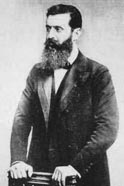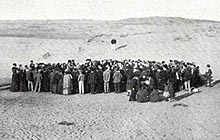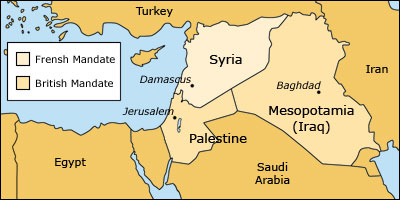|
The
History
of Israel
- A Chronological Presentation

2.
The Establishment of Israel (1880 - 1920)
1880 - The Jews in Palestine
The Turks had ruled Palestine as part of the Ottoman
Empire's Syrian province since conquering the entire
Middle East in the early 16th century. During all
these years a Jewish presence had continued to exist
in the area, mainly in the four holy cities of Safed,
Tiberias, Hebron and Jerusalem. The size of the Jewish
community had varied, in 1880 numbering around 25.000,
comprising about 1/10 of the total population.

The
Ottoman Empire, 1914.
1880 - First Wave of Immigration
from Europe
Oppression and persecution in 1880's Europe lead many
Jews to emigrate, especially from the Russian controlled
Eastern European provinces. One of the targets was Palestine.
In the first major wave of immigration an estimated
25.000 Jews arrived. Thus, at the turn of the century
there were about 50.000 Jews in Palestine, of a total
population of 350.000.
 |
 |
| Theodor
Herzl. |
1897 - Herzl and the Zionist
Idea
In respons to European anti-Semitism the Austrian-Jewish
journalist and writer Theodor Herzl in 1896 published
the book "Der Judenstaat" (The Jewish State).
He described a modern social-democratic soceity, in
which Jews would be able to live in peace and self-determination.
One year later at the first Zionist Congress (Zion
is another word for Israel) a world-wide organization
was founded with the explicit aim of "establishing
a home for the Jewish people in Palestine, guaranteed
under international law." Herzl and the
other Zionist leaders sought backing for the project
with the leadears of the major powers - the Ottoman
Empire, Germany and England. Only the latter showed
any interest in the idea.
 |
 |
Tel
Aviv is founded on the sand dunes along
the Mediterranian coast, 1909.
|
1904-14 - Second
Wave of Immigration
Renewed Russian pogroms at the start of the century
spurred another wave of immigration to Palestine.
Jewish organisations collected funds all over the
world and purchased land, on which the newly arrived
Jews established farms and towns. In 1909 the first
kibbutz (socialist agricultural community) was established,
and the same year the city of Tel Aviv was founded
close to the Arab port of Jaffa. Many Arabs also found
their way to Palestine during this time. In 1914 the
Jewish popolation had grown to 85.000, the Arab to
500.000.
1915-17 - Promises and Alliances
As Britain planned its invasion of the Ottoman Empire,
of which Palestine was a part, it tried to build alliances
in several directions. In 1915, in a secret correspondance
with the Emir of Mecca, Britain promised support for
Arab independence in the Middle East. In 1916 a secret
deal to divide the spoils of war was struck with France,
and in 1917 the British government issued the "Balfour
Declaration" promising the Zionist Organization
support for the establishment of "a national
home for the Jewish people" in Palestine.

The
British General Allenby enters Jerusalem, December 1917.
1917 - The British
Invasion
As the Ottoman Empire entered World War I on the side
of the Central Powers it was now at war with England,
and soon after British troops invaded all of the Ottoman
Middle East. In 1917 General Allenby conquered Jerusalem,
and one year after Damascus.
1920 - The Establishment
of "Mandates"
After the war the victors divided the Middle
East into a number of "mandate" areas, under
French and British administration. Syria (today Syria
and Lebanon) was awarded to France, while Palestine
(today's Jordan and Israel including Gaza and the West
Bank) and Mesopotamia (Iraq) came under British control.
The promise of the establishment of a national home
for the Jews in Palestine was integrated into the mandate
agreement.

The
mandates for Syria, Palestine and Mesopotamia.
Continue:
Chapter 2 - The Establishment of Israel - Page 2
Back
|